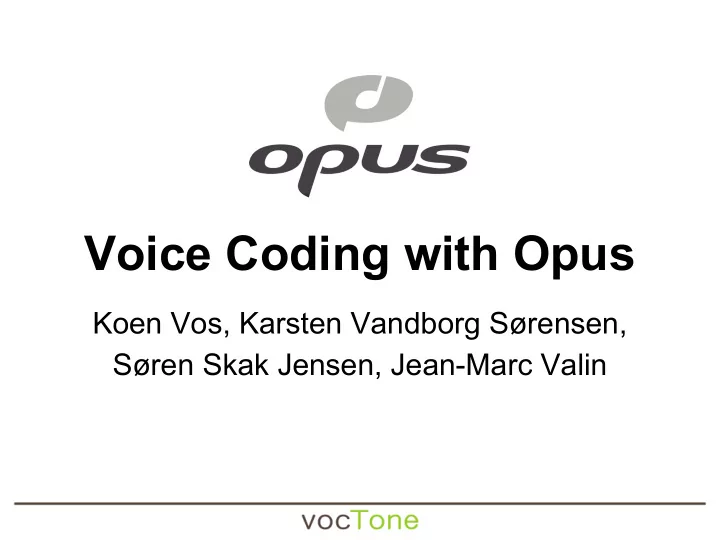

Voice Coding with Opus Koen Vos, Karsten Vandborg Sørensen, Søren Skak Jensen, Jean-Marc Valin
Two Opus presentations ● This talk: Voice Mode (Koen) ○ Features ○ Technology ○ Listening test results ● Next talk: Audio Mode (Jean-Marc)
What is Opus? ● Flexible speech and audio codec ● Best-in-class performance across a wide range of applications ● IETF Standard RFC 6716 (Sep. 2012) ● Royalty free ● Open source
Flexible Indeed ● Bitrates from 6 to 510 kbps ● Frame sizes from 2.5 to 60 ms ● Narrowband to full-band (in 5 steps) ● Speech and music ● Mono and stereo ● Rate control ● Variable complexity All changeable dynamically, signalled within the bitstream
Merging Two Codecs 1. SILK ○ Developed by Skype ○ Based on Linear Prediction ○ Efficient for voice ○ Up to 8 kHz audio bandwidth 2. CELT ○ Developed by Xiph.Org ○ Based on MDCT ○ Good for universal audio/music
Hybrid Mode For super-wideband or full-band voice
SILK Decoder Standard defines only the decoder ● Doesn’t get much simpler
SILK Encoder Standard includes high-quality reference implementation
Predictive Noise Shaping Quantization ● Linear short- and long-term prediction to model formants and harmonics ○ Reduce entropy of residual ● Short- and long-term emphasis filtering ○ Emphasize important spectral components ○ Reduce input noise ● Short- and long-term noise shaping ○ Mask quantization noise
Predictive Noise Shaping Quant. II
Predictive Noise Shaping Quant. III Example (short-term shaping only)
Stereo ● Mid-Side representation ● Side is predicted from mid; residual coded
Internet Robustness ● Forward Error Correction (FEC) ○ Include coarse encoding of previous packet, for active speech ● Flexible Error Propagation ○ Code packets more independently for channels with packet loss ● Discontinuous Transmission (DTX) ○ Reduce packet rate during silence ● Packet Loss Concealment (PLC) ○ Decoder side ○ Fills in DTX blanks
FEC
Flexible Error Propagation ● Reduce LTP filter state at beginning of a packet, in encoder and decoder ● Spend more bits only during first pitch period ● Other codecs constrain LTP filter coefficients and spend more bits throughout the packet
Effect of LTP scaling
Packet Loss Example ● Original ● AMR-WB, 30% packet loss ● Opus without FEC, 30% packet loss ● Opus with FEC, 30% packet loss
Listening Results: Narrowband Google Mushra Test
Listening Results: Wide/Full-Band Google Mushra Test
Questions? Find all things Opus at http://www.opus-codec.org
Recommend
More recommend